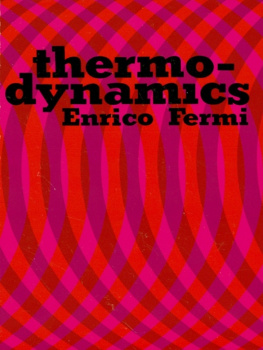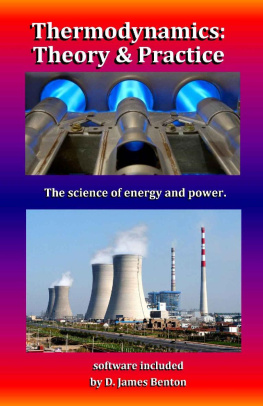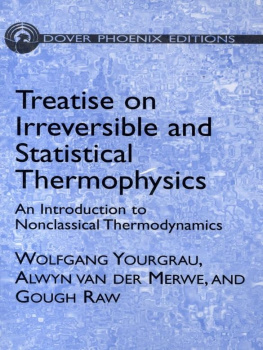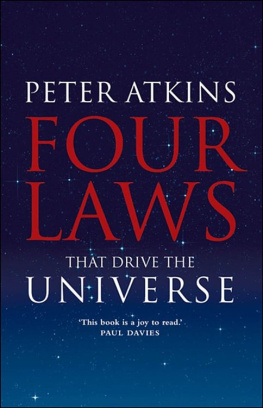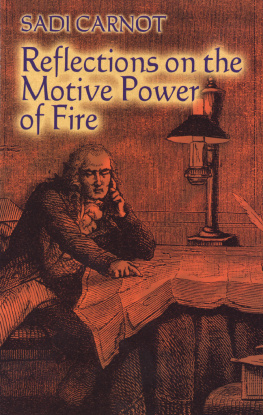Chandra - Energy, entropy and engines an introduction to thermodynamics
Here you can read online Chandra - Energy, entropy and engines an introduction to thermodynamics full text of the book (entire story) in english for free. Download pdf and epub, get meaning, cover and reviews about this ebook. year: 2016, publisher: John Wiley & Sons, Incorporated, genre: Romance novel. Description of the work, (preface) as well as reviews are available. Best literature library LitArk.com created for fans of good reading and offers a wide selection of genres:
Romance novel
Science fiction
Adventure
Detective
Science
History
Home and family
Prose
Art
Politics
Computer
Non-fiction
Religion
Business
Children
Humor
Choose a favorite category and find really read worthwhile books. Enjoy immersion in the world of imagination, feel the emotions of the characters or learn something new for yourself, make an fascinating discovery.

- Book:Energy, entropy and engines an introduction to thermodynamics
- Author:
- Publisher:John Wiley & Sons, Incorporated
- Genre:
- Year:2016
- Rating:5 / 5
- Favourites:Add to favourites
- Your mark:
- 100
- 1
- 2
- 3
- 4
- 5
Energy, entropy and engines an introduction to thermodynamics: summary, description and annotation
We offer to read an annotation, description, summary or preface (depends on what the author of the book "Energy, entropy and engines an introduction to thermodynamics" wrote himself). If you haven't found the necessary information about the book — write in the comments, we will try to find it.
Chandra: author's other books
Who wrote Energy, entropy and engines an introduction to thermodynamics? Find out the surname, the name of the author of the book and a list of all author's works by series.
Energy, entropy and engines an introduction to thermodynamics — read online for free the complete book (whole text) full work
Below is the text of the book, divided by pages. System saving the place of the last page read, allows you to conveniently read the book "Energy, entropy and engines an introduction to thermodynamics" online for free, without having to search again every time where you left off. Put a bookmark, and you can go to the page where you finished reading at any time.
Font size:
Interval:
Bookmark:
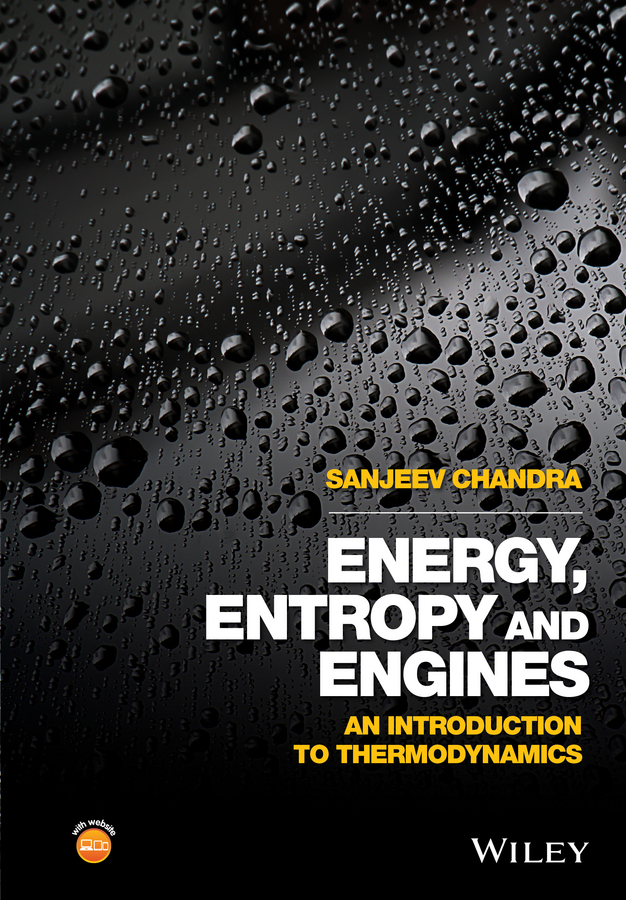
- Chapter 03
- Chapter 04
- Chapter 05
- Chapter 07
- Chapter 01
- Chapter 02
- Chapter 03
- Chapter 04
- Chapter 05
- Chapter 06
- Chapter 07
- Chapter 08
- Chapter 09
- Chapter 10
- Appendices
Sanjeev Chandra
University of Toronto, Canada

This edition first published 2016
2016 John Wiley & Sons, Ltd
Registered office
John Wiley & Sons, Ltd, The Atrium, Southern Gate, Chichester, West Sussex, PO19 8SQ, United Kingdom
For details of our global editorial offices, for customer services and for information about how to apply for permission to reuse the copyright material in this book please see our website at www.wiley.com.
The right of the author to be identified as the author of this work has been asserted in accordance with the Copyright, Designs and Patents Act 1988.
All rights reserved. No part of this publication may be reproduced, stored in a retrieval system, or transmitted, in any form or by any means, electronic, mechanical, photocopying, recording or otherwise, except as permitted by the UK Copyright, Designs and Patents Act 1988, without the prior permission of the publisher.
Wiley also publishes its books in a variety of electronic formats. Some content that appears in print may not be available in electronic books.
Designations used by companies to distinguish their products are often claimed as trademarks. All brand names and product names used in this book are trade names, service marks, trademarks or registered trademarks of their respective owners. The publisher is not associated with any product or vendor mentioned in this book.
Limit of Liability/Disclaimer of Warranty: While the publisher and author have used their best efforts in preparing this book, they make no representations or warranties with respect to the accuracy or completeness of the contents of this book and specifically disclaim any implied warranties of merchantability or fitness for a particular purpose. It is sold on the understanding that the publisher is not engaged in rendering professional services and neither the publisher nor the author shall be liable for damages arising herefrom. If professional advice or other expert assistance is required, the services of a competent professional should be sought.
The advice and strategies contained herein may not be suitable for every situation. In view of ongoing research, equipment modifications, changes in governmental regulations, and the constant flow of information relating to the use of experimental reagents, equipment, and devices, the reader is urged to review and evaluate the information provided in the package insert or instructions for each chemical, piece of equipment, reagent, or device for, among other things, any changes in the instructions or indication of usage and for added warnings and precautions. The fact that an organization or Website is referred to in this work as a citation and/or a potential source of further information does not mean that the author or the publisher endorses the information the organization or Website may provide or recommendations it may make. Further, readers should be aware that Internet Websites listed in this work may have changed or disappeared between when this work was written and when it is read. No warranty may be created or extended by any promotional statements for this work. Neither the publisher nor the author shall be liable for any damages arising herefrom.
Library of Congress Cataloging-in-Publication data applied for
ISBN: 9781119013150
A catalogue record for this book is available from the British Library.
To my wife Smita, whose support has made everything possible,
and my sons Rohan and Varun, always my favourite students.
This book is a text for teaching a one-semester, introductory engineering thermodynamics course. Its most important goal is to make students understand the meaning of fundamental concepts such as energy, entropy, equilibrium and reversibility, which form the foundation of engineering science. It uses simple, direct language and relies on physical rather than abstract, mathematical definitions. Every new concept is introduced starting from first principles, and only after explaining why it is necessary.
Thermodynamics is different from most other engineering courses, in that it expects students to grasp an entirely new concept, entropy, which they have never encountered before. Traditional thermodynamics texts resort to giving a purely mathematical definition of entropy, and students learn to use the property for solving problems without ever forming a physical picture of what it means. This book introduces entropy by combining macroscopic definitions with statistical descriptions based on the energy distribution of molecules. Readers are not expected to learn statistical mechanics but use analogies to acquire an intuitive grasp of the concept of entropy and understand why the second law of thermodynamics is a result of the laws of probability.
, including Newtons laws, the definitions of kinetic and potential energy, molar quantities and the ideal gas equation and can review these sections independently.
Thermodynamics textbooks typically start, immediately after the introduction, by teaching how to read tabulated properties of saturated liquids and vapours. Students are immediately overwhelmed by terms such as internal energy and enthalpy before they understand how these properties are used, and they are left with the impression that thermodynamics is largely an exercise in reading tables and charts. In the first six chapters of this book, while students are still becoming familiar with the laws of thermodynamics, there is no discussion of phase change. Once the second law has been understood liquidvapour mixtures are treated as systems in equilibrium that can be analysed using the laws of thermodynamics. ) without any loss of continuity.
It should be possible to cover the entire book in a one-semester introductory course that teaches the fundamentals of thermodynamics and their application in the analysis of heat engines and refrigerators. A slower paced course may leave out discussions of exergy (.
This book is accompanied by a companion website:
- www.wiley.com/go/chandraSol16
The website includes:
- Solutions for the Problems given at the end of each chapter.

Introduction : A Brief Historyof Thermodynamics
- Review the historical development of heat engines.
- Learn how thermodynamics grew out of efforts to improve the performance of heat engines.
- Gain an overview of concepts such as energy and entropy and the laws of thermodynamics.
When earths creatures were created, according to Greek legends, each received its own gift of speed or strength or courage. Some animals received wings to soar on, others claws to defend themselves, but finally, when it was the turn of humans, nothing remained. Prometheus saved mankind by stealing fire from the gods, making people far more powerful than any animal. Such myths and similar stories exist in almost every society trace the birth of human civilisation to the discovery of fire, which gave warmth, nourishment and the ability to craft objects out of stone and metal.
Next pageFont size:
Interval:
Bookmark:
Similar books «Energy, entropy and engines an introduction to thermodynamics»
Look at similar books to Energy, entropy and engines an introduction to thermodynamics. We have selected literature similar in name and meaning in the hope of providing readers with more options to find new, interesting, not yet read works.
Discussion, reviews of the book Energy, entropy and engines an introduction to thermodynamics and just readers' own opinions. Leave your comments, write what you think about the work, its meaning or the main characters. Specify what exactly you liked and what you didn't like, and why you think so.





